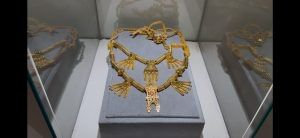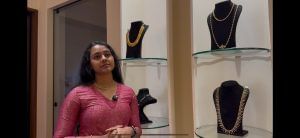Karaikudi, Sivaganga district: In Tamil Nadu’s Karaikudi, known for its grand mansions and intricate courtyards, a new jewellery museum is set to open. From 2 October, Karaikudi will host “Pettagam”—India’s first private jewellery museum dedicated to Chettinad Jewellery.
Located on the narrow SRM streets of Karaikudi, the museum is the fruition of jewellery designer Meenu Subbiah’s three-decade-long efforts to revive a jewellery tradition that once defined the prosperity and travel history of Nagarathar (Nattukottai Chettiar) community in the southern part of the state.
Stating that the Nagarathar community once comprised fearless traders who carried the culture of Chettinad to foreign shores through seas and brought global influence in Chettinad, Meenu said that their jewellery designs and culture reflect the community’s journey.
“The jewellery design by itself tells the stories of the travel, trade and the perseverance of the community. Pettagam is my attempt to make sure these stories are not lost,” Meenu told ThePrint.
The museum borrowed its name from the community’s tradition. Meenu said every Nagarathar household once used to keep a “pettagam”(locker), an iron strongbox, which was used to store gold, diamonds, and other pearls bought domestically and from abroad.

The museum is designed in a typical Chettinad style, where the ground floor traces the history of the Nagarathars and their jewellery.
Visitors walking into Pettagam are first drawn to two of the most important ornaments in the Nagarathar tradition, the Kazhuthuru, a heavy gold bridal necklace made of 34 interlinked pieces, and the Gauri Shankaram, a ceremonial jewel worn by men at old age.
Alongside these, the museum also displays flexible necklaces studded with rubies and emeralds, jewels seen in 19th-century photographs of the elderly in the community, and bangles designed with crab and conch patterns.
The showcase on the ground floor also displays a kasu mala (coin necklace) with rows of gleaming gold coins, a flexible diamond chain with a ruby pendant, and a ruby-diamond close-set necklace with a peacock pendant. Each of them displays the meaning of Chettinad jewellery ritual, the wealth and global influence of the community.
Meenu said that the Chettinad jewels were not old-fashioned, but are timeless.
“I wouldn’t say these jewellery are old-fashioned as well. Because of their international exposure, the Nagarathars created jewellery that is still modern, and people are still using it in their family customs like marriage, engagement etc,” she said.
The jewellery also opens a window into the larger Chettinad culture of the Nagarathar community. The Nagarathars, who rose as traders and financiers from the early medieval period, were influenced by their travel to Burma, Sri Lanka, and other Southeast Asian countries. Their jewellery reflected their journey by making use of the imported gems, including Burmese rubies. Over the period of time, what began as ritual and identity markers today stands as a cultural archive.
Journey of Pettagam Museum
Meenu shared that she was inspired to set up such a museum around 30 years ago when she was just 20 years old.
“I grew up looking at the ornaments worn by my grandmothers and great-grandmothers. As I began designing at a young age, I kept drawing those designs, and I was very much interested to know what the previous generations used to wear. It was then, I began to start researching it,” Meenu told ThePrint.
She began studying Chettinad jewellery about 30 years ago, soon after launching her jewellery business. She dived deeper into her research 20 years ago, and travelled abroad several times to look for the ancient jewellery of Chettinad.

Prabhakar Thamilarasu | ThePrint
“I thought there is so much more in this region. Then, it struck me, why not work on bringing it back? Since there was not much documentation, it was a huge task. I had to talk to people, knock on the doors of elders, and meet historians,” she said.
Noting that many of those elders whom she spoke to are no longer alive, she said that she was fortunate enough to have spoken to them at the right time.
“Those conversations gave me insights that I couldn’t have found anywhere else,” Meenu told ThePrint.
Meenu, who travelled to different temples to know the jewellery made for deities, recalled that she also learnt from the black and white photographs available in the temples and from the community elders.
“Even 250–300 years back, the Nagarathars were wearing jewels decorated with gems and metal works. They even had a flexible, close-setting necklace with rubies or emeralds. Photographs were my biggest teachers to recreate those old jewels,” she recalled.
Also read: What’s the big deal about the Harappa Dancing Girl that even a replica is stolen
The challenges of preservation
Meenu, who began her research in an era before smartphones, relied on her memory, hand drawings, and her imagination.
“Pictures were not possible when I began the research. Most of the time, even to have a glance at the jewels would be a herculean task. So I always carried papers and pencils. The moment I see something, I used to sketch it immediately. Later, I would refine it, trying to visualise what I had seen,” Meenu recalled.
She added that the whole process of stitching the fragments of temple jewellery, faded photographs, oral histories from the community elders and some give-away jewellery for preservation has come today for the Pettagam museum.
While Meenu had the vision and worked on the research, her daughter Adithi Ganeshan, who serves as the COO of Pettagam, has been taking care of the execution part of the museum.
Speaking to ThePrint, Adithi said that the museum is as much about the future as it is about the past of the region’s people.
“We wanted Pettagam, not just a display of jewellery cases, but a space where people can experience jewellery as a culture. We hope that it will spark a curiosity in the younger generations who may have grown up elsewhere, leaving their native place, but still feel connected to their roots,” Adithi told ThePrint.
She also explained that the museum has given a platform to the artisans who made these jewels.
“Many of the craftsmen we work with are from families who once supplied to Chettinad households. Pettagam gives visibility to their work and values them for what they have been doing for years. It is also an attempt to revive the traditional techniques of making these jewellery since they are at risk of fading away,” Adithi added.
Karaikudi, which draws visitors for its heritage mansions, antique vessel markets, and floor tiles, will soon see Pettagam as another cultural landmark to cherish their ancient past.
“Every family once had a pettagam. Now Karaikudi has one that belongs to everyone,” Meenu said.
(Edited by Saptak Datta)






